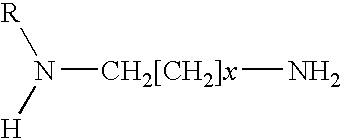Molybdenum-containing lubricant additive compositions and processes for making and using same
a technology of molybdenum and additives, which is applied in the direction of fatty acid chemical modification, group 6/16 organic compounds without c-metal linkages, fuels, etc., can solve the problems of oxidative degradation of oil, add considerable cost to the manufacturing of these additives, and achieve high incorporation efficiency, low cost, and improved reaction product deposit control performance
- Summary
- Abstract
- Description
- Claims
- Application Information
AI Technical Summary
Benefits of technology
Problems solved by technology
Method used
Image
Examples
example 1
Preparation of Sulfur-Free Organomolybdenum Additive (Sample No. 1)
[0053]A. Preparation of Amide Organic Ligand Intermediate Reaction Product
[0054]RBD Canola Oil (250.0 g, 0.277 mol) was added to a 500 mL resin kettle equipped with a reflux condenser, an addition funnel, a thermometer, a mechanical stirrer, and a heating mantle. Dry nitrogen was passed into the reactor through the addition funnel, and out of the reactor through the reflux condenser. The Canola Oil was heated to 80° C. and isodecyloxypropyl-1,3-diaminopropane (135.0 g, 0.458 mol) was added dropwise over 45 minutes. During the amine addition the reaction temperature was held at 80° C. The reaction mixture was then heated to 125° C. and held at that temperature, under nitrogen and with sufficient agitation, for 5½ hours. The reaction was cooled overnight.
[0055]B. Molybdenum Incorporation—Preparation of Organomolybdenum Derivative Complex Product
[0056]The amide mixture intermediate reaction product, prepared as describe...
example 2
Evaluation of Organomolybdenum Additives in the Caterpillar Micro-Oxidation Test
[0062]Organomolybdenum complexed product samples 1-9, as prepared in Example 1, were evaluated as additives in a modified version of the Caterpillar Micro-Oxidation Test (CMOT). Each additive was added to a separate amount of SAE grade 15 W-40 fully formulated crankcase oil containing approximately 1000 ppm of phosphorus derived from ZDDP and 0.5 weight % of an alkylated diphenylamine antioxidant. This provided test Oils 1-9. A Comparison Oil was also tested in which the crankcase oil contained no molybdenum additive. The particular organomolybdenum complexed product among samples 1-9 used in each sample of base oil is indicated in Table 3. The additive treat levels were such that approximately 160 to 170 ppm of molybdenum was delivered to the respective finished Oils 1-9. For additives in the 8% molybdenum content range, this corresponds to 0.20 wt % of additive added to the lubricating oil formulation....
example 3
Evaluation of Organomolybdenum Additives for Oil Coloration
[0069]A color and visual solubility were determined for the molybdenum complexed compounds of sample nos. 1-8, as described in Example 1, using a paraffinic process oil diluent (PO#5). The color method was ASTM D 1500. Color results are reported to the nearest one-half unit match on the D1500 color scale. The treat levels were 1 wt. % for each tested sample, in which the treat level is based upon the amount (weight percent) of the molybdenum compound added to the process oil, not the amount of molybdenum delivered to the process oil. An additional sample, sample no. 11, was prepared and tested in a similar manner for solubility and color in which the organomolybdenum complexed product used was prepared in the manner described for additive Sample M6 as described in European published patent application EP 1 136 496 A1. The M6 additive involves the reaction product of 2-(2-aminoethylamino) ethanol and canola oil in which an or...
PUM
| Property | Measurement | Unit |
|---|---|---|
| Temperature | aaaaa | aaaaa |
| Temperature | aaaaa | aaaaa |
| Temperature | aaaaa | aaaaa |
Abstract
Description
Claims
Application Information
 Login to View More
Login to View More - R&D
- Intellectual Property
- Life Sciences
- Materials
- Tech Scout
- Unparalleled Data Quality
- Higher Quality Content
- 60% Fewer Hallucinations
Browse by: Latest US Patents, China's latest patents, Technical Efficacy Thesaurus, Application Domain, Technology Topic, Popular Technical Reports.
© 2025 PatSnap. All rights reserved.Legal|Privacy policy|Modern Slavery Act Transparency Statement|Sitemap|About US| Contact US: help@patsnap.com



